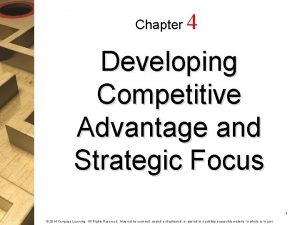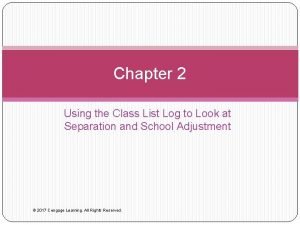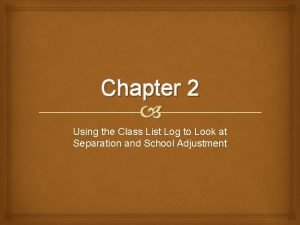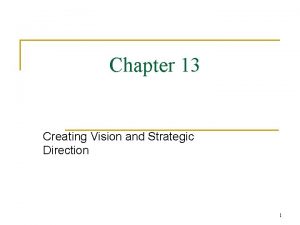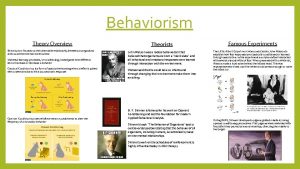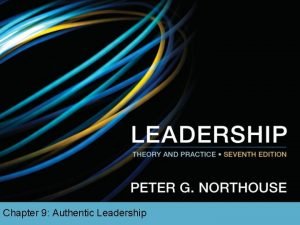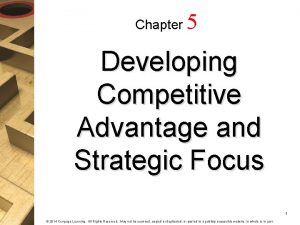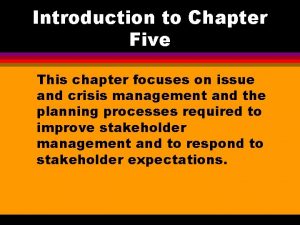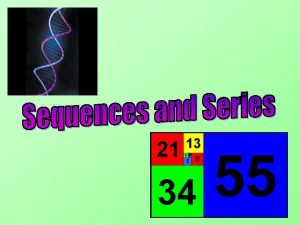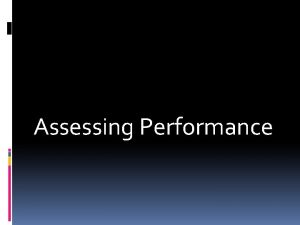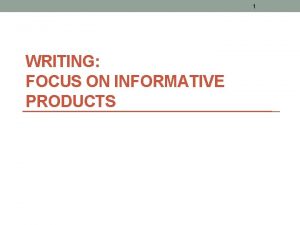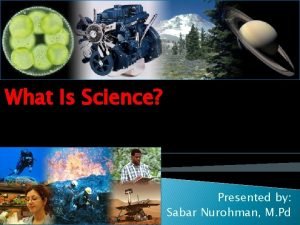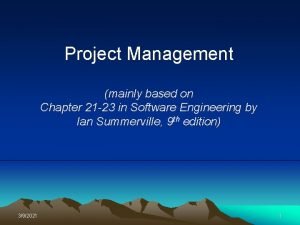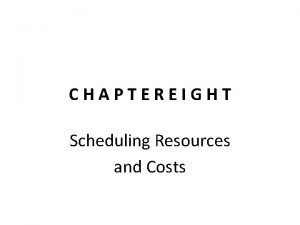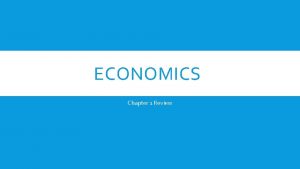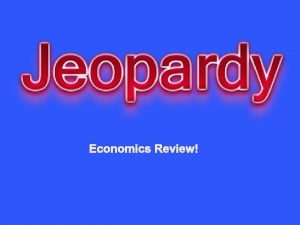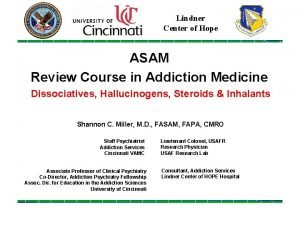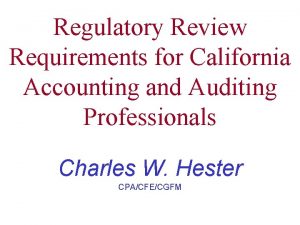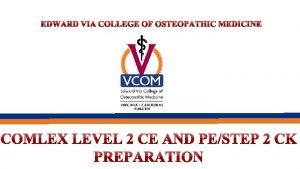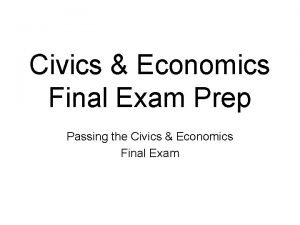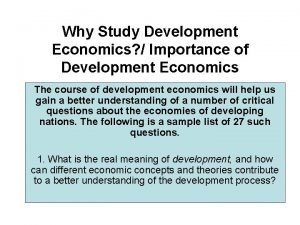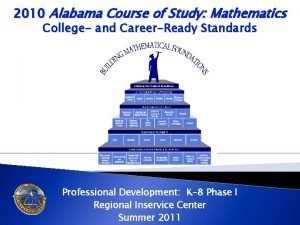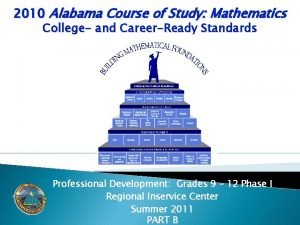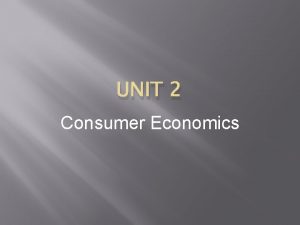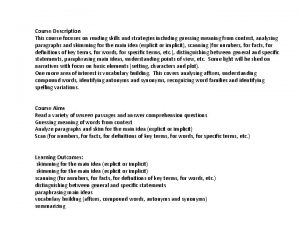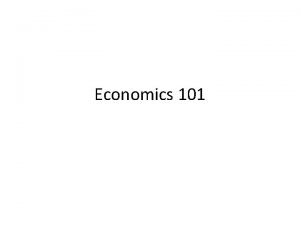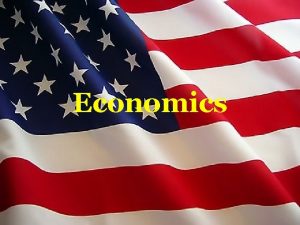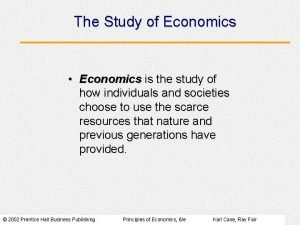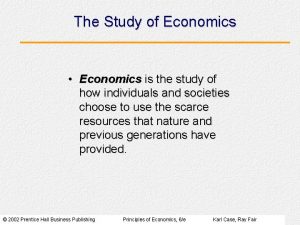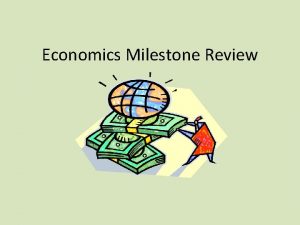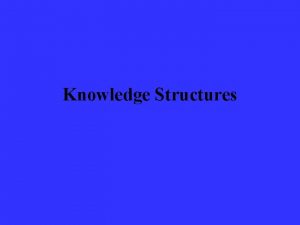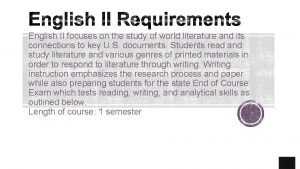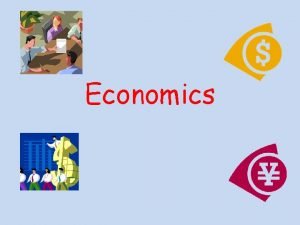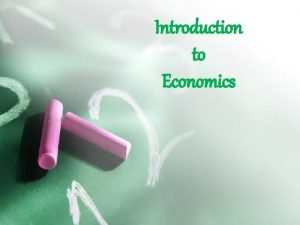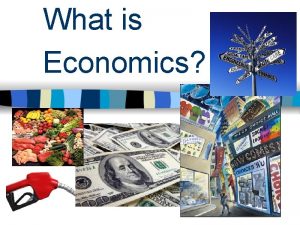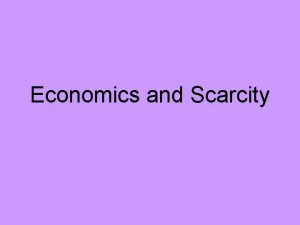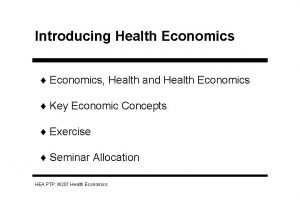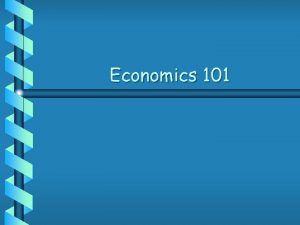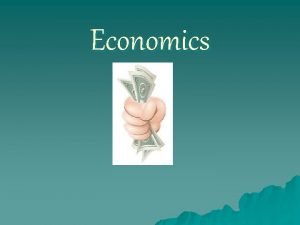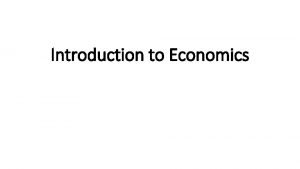Economics Review This course focuses on the study



























































- Slides: 59

Economics Review

This course focuses on the study of economic problems and the methods by which societies solve them. Characteristics of the market economy of the United States and its function in the world and methods of applying economics to one's life will be explored. Standard 1 Students will understand the economic condition of scarcity where individuals, businesses, governments, societies, and nations must make choices in attempting to satisfy unlimited wants and needs using limited resources. Objective 1 Define economics using the main ideas that wants and needs are unlimited but resources are limited, resulting in scarcity. 1. Give historical examples of how scarcity forces individuals, businesses, governments, societies, and nations to make choices in allocating limited resources. 2. Demonstrate understanding of how scarcity forces individuals, businesses, governments, societies, and nations to make choices in allocating limited resources in our present society. 3. Identify the productive resources/factors of production (Human Resources/Labor, Natural Resources/Land, Capital Resources) and give examples of each. 4. Determine the difference between a good and a service, and identify productive resources that are used in the production of various goods and services. 5. Explain the difference between wants and needs, and give examples of each.

Economics • The Science of Scarcity • Or the Science of Choice • The study of people producing and exchanging to get the things they want. • The study of how individuals and societies make choices about ways to use scarce resources to fulfill their wants.

Scarcity • We have scarcity, because we have unlimited needs and wants, but limited resources. • Needs – things that are essential to sustain life. • Wants – things that are desirable, and add enjoyment to life.

Choice • Because we have scarcity, we are forced to make choices. • Everything that exists is limited.

Factors of Production • • Land Labor Capital Entrepreneurship

Objective 2 Compare and contrast the concepts of opportunity cost and trade-offs using production possibilities curves. 1. Define opportunity cost. 2. Define trade-offs. Give examples of opportunity cost and trade-offs as they apply to individuals, businesses, governments, societies, and nations. 3. Design a production possibilities curve to illustrate trade-offs.

Opportunity Cost • When we choose between alternatives that offer different benefits we must realize that there will be “Trade Offs. ” • Choosing is refusing the next best alternative.

Production Possibilities Curve

Objective 3 List the basic economic questions (what will be produced, how will it be produced, and for whom it will be produced) and describe how different economic systems (traditional, command, market, mixed) address these questions. 1. Define traditional, command, market, and mixed economic systems. 2. Explain how the basic economic questions were applied in the early United States. 3. Identify the economic systems used in countries around the world today.

3 Economic Questions • What to produce? • Who will produce it? • For whom will it be produced?

Four Types of Economic Systems 1. Traditional – Customs, Traditions (Pioneers, Pilgrims) 2. Market – Free Enterprise, Capitalism (U. S. A. ) 3. Command – Communism / Dictatorship (Cuba) 4. Mixed – Socialism / High degree of Government intervention + Market (Sweden, France, Italy)

Objective 4 Use marginal analysis to illustrate the six-step decision making process. 1. Define marginal analysis. 2. Define the six-step decision making process. 3. Apply marginal analysis to an economic choice a student must make (e. g. , buying a car, deciding on plans after high school, selecting a college/university, etc. ). 4. Identify how a business might apply marginal analysis.

Marginal Analysis Marginal Cost should be less than Marginal Benefit MC < MB

Marginal Analysis The Law of Diminishing Returns

6 Step Decision Process 1. 2. 3. 4. 5. 6. Identify/Define the Problem/Opportunity Study the Environment List all Possible Alternatives Collaborate & Choose the Best Alternative Launch Your Plan Evaluate Your Progress, and Continue or Start over.

Standard 2 Students will understand that resources and goods/services are allocated by voluntary exchange and that economic markets are characterized by supply, demand, competition, incentives, and property rights. Objective 1 Define markets and explain how they allocate scarce resources. 1. Describe how voluntary exchange between households and businesses creates a circular flow of money, products, and resources. 2. Construct a circular flow model/diagram for both market and mixed economic systems demonstrating the process of voluntary exchange among businesses/producers, households/consumers, and government.

Voluntary Exchange • Two or more people exchanging things of value voluntarily.

Tender vs. Barter Legal Tender Barter

The Circular Flow of Economic Activity Business Income $ Product Markets Goods & Services Business Individuals Land Capital Labor Entrepreneurs Buy Productive Resources $ Payments for Resources $ Consumer Spending Factor Markets $ Income from Resources

Objective 2 Determine why incentives, competition, voluntary exchange and property rights are important components of market economies. 1. Define incentives, competition, voluntary exchange, and property rights. 2. Give examples of how people respond predictably to incentives (entrepreneurship). 3. Describe the advantages of competition among households/consumers as well as among producers/businesses.

The 4 Pillars of Free Enterprise 1. Incentives (Entrepreneurship) 2. Competition 3. Voluntary Exchange 4. Property Rights (The Rule of Law)

Objective 3 Discuss the laws of supply and demand explain price determination. 1. Define supply and demand. 2. Define the determinants of supply and demand. 3. Describe how the concepts of the substitution effect and diminishing marginal utility apply to demand. 4. Use supply and demand schedules to plot curves on a graph and predict how changes/shifts in either supply or demand will affect the market and have an impact on price.

The Law of Demand • As the price of a good or service decreases consumers will want to by more of it, and visa versa:

The Law of Supply • As the price of a good or service increases suppliers will want to make more of it, and visa versa:

Equilibrium or Market Clearing Price

Shift in Demand

Price Elasticity

Objective 4 Compare and contrast different market structures. 1. List the characteristics of the four market structures: perfect competition, monopolistic competition, oligopoly, and monopoly. 2. Identify business sectors that illustrate each of the market structures. 3. Explain the role of anti-trust laws as they apply to market competition.

4 Market Structures 1. Perfect Competition - markets such that no participants are large enough to have the market power to set the price of a homogeneous product, i. e. the auto industry. 2. Monopolistic Competition – sellers whose products are similar but not identical and that takes the form of product differentiation and advertising with less emphasis upon price. 3. Oligopoly - similar to a monopoly, except a few companies working together to limit or eliminate competition. 4. Monopoly - a single company or group owns all or nearly all of the market for a given type of product or service. By definition, monopoly is characterized by an absence of competition, which often results in high prices and inferior products.

Objective 5 Discuss various economic theories and the economists who developed those theories as they relate to market economies. 1. Explain Adam Smith’s theories of the invisible hand laissez faire as discussed in his book, The Wealth of Nations. 2. Explain John Maynard Keynes’ theories on economic stabilization through government intervention. 3. Explain Karl Marx’s and Frederick Engels’ theories on socialism and communism. 4. List some modern-day economists and their recent economic theories.

3 Economic Theories • Adam Smith – “The Wealth of Nations” – The Invisible Hand – Self Interest (Free Market) • John Maynard Keynes – Keynesian Economics – Economic Stabilization through Government Intervention (Socialism) • Karl Marx & Frederick Engels – “The Communist Manifesto” & “Das Kapital” – The end justifies the means.

Wealth of Nations • Written by Adam Smith in 1776 • Provided the basis for our economic system of free trade and capitalism • Along with Thomas Payne’s “Common Sense” gave the literary motivation that helped fuel the Revolutionary War with Great Brittan • The invisible hand of self-interest results in the greatest good for society

Standard 3 Students will recognize how fiscal and monetary policies assist individuals and groups in pursuit of economic well-being. Objective 1 Analyze how policymakers use fiscal policy to accomplish their goals regarding the U. S. economy. 1. Discuss the main economic goals of the U. S. —providing public goods, ensuring competition, dealing with externalities, and promoting economic stability, security, and growth. 2. Explain how fiscal policy is used by federal, state, and local governments. 3. Explain how fiscal policy can lead to government failure. 4. Examine the different types of taxes governments use to raise revenue (e. g. , progressive, regressive, proportional) and list the various taxes that governments levy (e. g. , income tax, property tax, sales tax, etc. ).

Government Economic Goals 1. Providing Public Goods 2. Ensuring Competition 3. Dealing with Externalities - An externality is a consequence of an economic activity that is experienced by unrelated third parties. An externality can be either positive or negative. 4. Promoting Economic Stability 5. Security 6. Growth

Monetary & Fiscal Policy • Monetary Policy – The Federal Reserve Bank – Discount Rate / Interest Rates / Increase or Decrease – Reserve Requirement / Credit / Loose or Tight • Fiscal Policy – The Executive Branch – The Federal Budget / Surplus or Deficit / Inflation

Objective 2 Identify the four phases of the business cycle and examine the role of economic indicators in determining the level of business activity. 1. Create and label a business cycle graphic. 2. Discuss Gross Domestic Product (GDP), how it is measured, and how it can indicate decline, growth, recession, and recovery. 3. Define labor force and how unemployment is calculated. 4. Define the different types of unemployment (i. e. , frictional, structural, cyclical, and seasonal).

Gross Domestic Product (GDP) • The total value of goods produced and services provided in a country for a specific time period (Quarter or Year). • Two successive quarters (3 months each) of a decline in GDP is classified as a recession.

Four Types of Unemployment 1. 2. 3. 4. Frictional – Temporary Transition Structural – Lack of Skills Cyclical – Economic Contraction Seasonal – Temporary Work due to the season of the year

Objective 3 Describe the functions of money and explain the role of financial institutions, the Federal Reserve Bank, and government in the fluctuation of the money supply. 1. Explain the three functions of money (i. e. , medium of exchange, store of value, measure of price). 2. Explain the responsibilities of the Federal Reserve (i. e. , supervise and regulate banks, administer monetary policy, and provide financial services for the U. S. government and member banks). 3. Examine how the Federal Reserve uses monetary policy tools to stimulate the economy or control inflation. 4. Compare fiscal and monetary policy, and summarize how the use of these policies affects individuals, businesses, governments, societies, and nations.

Federal Reserve System • The central bank of the United States. The Fed, as it is commonly called, regulates the U. S. monetary and financial system. The Federal Reserve System is composed of a central governmental agency in Washington, D. C. (the Board of Governors – 7 members for 14 years) and 12 regional Federal Reserve Banks in major cities throughout the United States.

3 Purposes of Money 1. Medium of Exchange 2. Store of Value 3. Measure of Price

Objective 4 Examine the role of entrepreneurs, businesses, and producers in market economies. 1. Define and analyze the different forms of business organization (i. e. , sole proprietorship, partnership, and corporation). 2. Identify and analyze how businesses raise capital (i. e. , debt financing vs. equity financing). 3. Determine how businesses earn a profit by creating value in their product (good, service, or idea).

3 Forms of Business Organization 1. Sole Proprietorship (One Owner – Full Liability) 2. Partnership (Two or More Owners – Partial Liability) 3. Corporation (Many Owners – No Liability) 1. C-Corp: Public Corporation (Public – No Liability) 2. S-Corp: Subchapter S Corporation (Privately Held – No Liability) 3. LLC: Limited Liability Company (Many Owners – No Liability)

Standard 4 Students will recognize how to increase productivity and the standard of living. Objective 1 Analyze how specialization and division of labor affect productivity, standard of living, and interdependence. 1. Explain the operation of supply and demand in the mixed-market economy of the United States. 2. Evaluate how a worker’s income is affected by education and the supply and demand of labor. 3. Determine how investments in human resources, physical resources, and technology affect productivity. 4. Explain how increased productivity can increase standard of living.

Education and Your Standard of Living

Objective 2 Understand the impact of saving, investing, and spending on the economy. 1. Define the marginal propensity to save and the marginal propensity to consume. 2. Explain the multiplier effect. 3. Discuss how businesses make investment decisions and the impact it has on the economy.

Multiplier Effect • An effect in economics in which an increase in spending produces an increase in national income and consumption greater than the initial amount spent.

Objective 3 Discuss the role of ethics in choices made by individuals, businesses, societies, governments, and nations. 1. Define ethics. 2. Evaluate a current ethical scenario.

Ethics The basic concepts and fundamental principles of decent human conduct. It includes study of universal values such as the essential equality of all men and women, human or natural rights, obedience to the law of the land, concern for health and safety, and increasingly, also for the natural environment.

Standard 5 Students will understand the economic impact of a changing global economy. Objective 1 Summarize the costs and benefits of international trade. 1. Define import and export. 2. Examine the impact of a country’s balance of trade on its Gross Domestic Product and standard of living. 3. Analyze the impact of barriers to trade. 4. Discuss trade organizations, trade agreements, and protectionist views.

Imports & Exports 1. Imports - A good or service brought into one country from another. 2. Exports - goods produced in one country are shipped to another country for future sale or trade. The sale of such goods adds to the producing nation's gross output. If used for trade, exports are exchanged for other products or services.

Global Economy • 3 methods a nation can use to curtail imports: – Tariffs (Import Tax) – Quotas (Limits on Volume) – Embargos (Blockade) • Exchange Rates (Dollars / Euros, or Yen) • Balance of Trade (Imports = Exports)

Objective 2 Use absolute advantage and comparative advantage to make trade decisions. 1. Define absolute advantage. 2. Define comparative advantage. 3. Explain how comparative advantage is used in analyzing trade decisions.

Trade Decisions Absolute Advantage - the ability of a country to produce a greater quantity of a good, or service than competitors, using the same amount of resources due to their expertise and commitment. Comparative Advantage - the ability to produce goods and/or services at a lower opportunity cost than other firms or individuals due to a country’s natural resources.

Objective 3 Explore the effects of currency exchange rates on international trade and travel. 1. Explain and calculate currency conversions. 2. Determine how the price of an imported good is affected by currency fluctuations. 3. Discuss how a country’s exports can be impacted by currency fluctuations.

Currency Implications Exchange Rates - Price for which the currency of a country can be exchanged for another country's currency. Balance of Trade - the difference between a country's imports and its exports. Balance of trade is the largest component of a country's balance of payments.

Objective 4 Examine the challenges that nations and the world face as economies throughout the world develop and change. 1. Discuss how political systems and economies in many countries are changing. 2. Study the role of the U. S. in today’s global economy.

Global Economy Impact on Domestic Economy 1. Balance of trade / balance of payments 2. Exchange rates 3. Strength of currency 4. Foreign Trade Agreements (NAFTA, AFTA) 5. Exporting jobs (manufacturing) 6. Unemployment 7. GDP (Economic) Growth
 Maastricht university school of business and economics
Maastricht university school of business and economics Mathematical economics vs non mathematical economics
Mathematical economics vs non mathematical economics One and a half brick wall
One and a half brick wall Course title and course number
Course title and course number Course interne moyenne externe
Course interne moyenne externe 14 line sonnet about love
14 line sonnet about love Psychoanalytical criticism
Psychoanalytical criticism Developing a firm's strategy canvas focuses on
Developing a firm's strategy canvas focuses on What is a class list log
What is a class list log Effective software project management focuses on
Effective software project management focuses on The false mirror
The false mirror Sociology of physical activity focuses on
Sociology of physical activity focuses on What is a class list log
What is a class list log Creating vision and strategic direction
Creating vision and strategic direction Behaviorism focuses on
Behaviorism focuses on A coaching relationship focuses on providing marines
A coaching relationship focuses on providing marines Lens of literary criticism
Lens of literary criticism Sharing of diverse information through universal web access
Sharing of diverse information through universal web access Authentic leadership focuses on
Authentic leadership focuses on Developing a firms strategy canvas focuses on
Developing a firms strategy canvas focuses on This chapter focuses on
This chapter focuses on Series and sequence
Series and sequence External synoynm
External synoynm Management focuses on
Management focuses on Expansion sentence examples
Expansion sentence examples Sabar nurohman
Sabar nurohman Principles of romanticism
Principles of romanticism Organizational restructuring
Organizational restructuring Gsm protocol
Gsm protocol Scheduling time-constrained projects focuses on resource
Scheduling time-constrained projects focuses on resource Economics chapter 1 review
Economics chapter 1 review Unit 1 review economics
Unit 1 review economics Kusum viswanathan
Kusum viswanathan Hbs practice test
Hbs practice test Dr henry lindner
Dr henry lindner California cpa regulatory review course
California cpa regulatory review course Allergy board review course
Allergy board review course Comlex pe videos stream
Comlex pe videos stream Stanford hci group
Stanford hci group Civics and economics final exam study guide
Civics and economics final exam study guide Development economics
Development economics Alabama course of study math
Alabama course of study math Alabama course of study math 2019
Alabama course of study math 2019 Hình ảnh bộ gõ cơ thể búng tay
Hình ảnh bộ gõ cơ thể búng tay Ng-html
Ng-html Bổ thể
Bổ thể Tỉ lệ cơ thể trẻ em
Tỉ lệ cơ thể trẻ em Chó sói
Chó sói Chụp phim tư thế worms-breton
Chụp phim tư thế worms-breton Chúa sống lại
Chúa sống lại Kể tên các môn thể thao
Kể tên các môn thể thao Thế nào là hệ số cao nhất
Thế nào là hệ số cao nhất Các châu lục và đại dương trên thế giới
Các châu lục và đại dương trên thế giới Cong thức tính động năng
Cong thức tính động năng Trời xanh đây là của chúng ta thể thơ
Trời xanh đây là của chúng ta thể thơ Mật thư anh em như thể tay chân
Mật thư anh em như thể tay chân Làm thế nào để 102-1=99
Làm thế nào để 102-1=99 độ dài liên kết
độ dài liên kết Các châu lục và đại dương trên thế giới
Các châu lục và đại dương trên thế giới Thể thơ truyền thống
Thể thơ truyền thống







